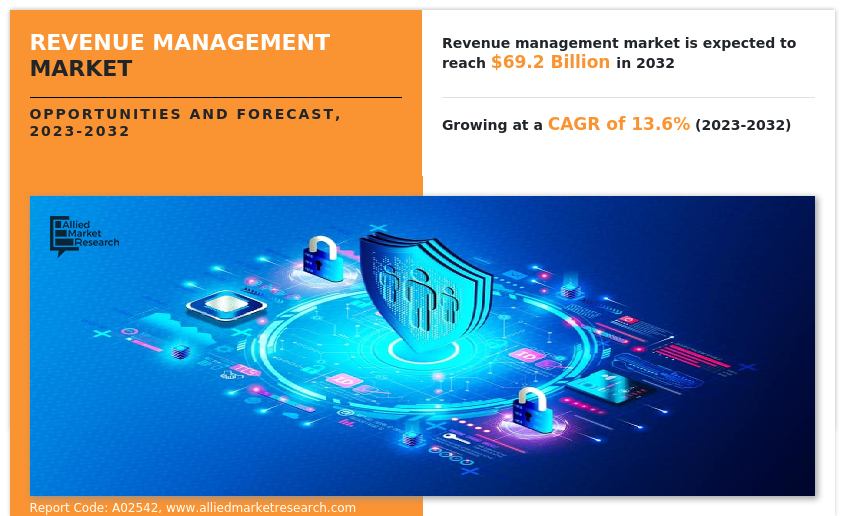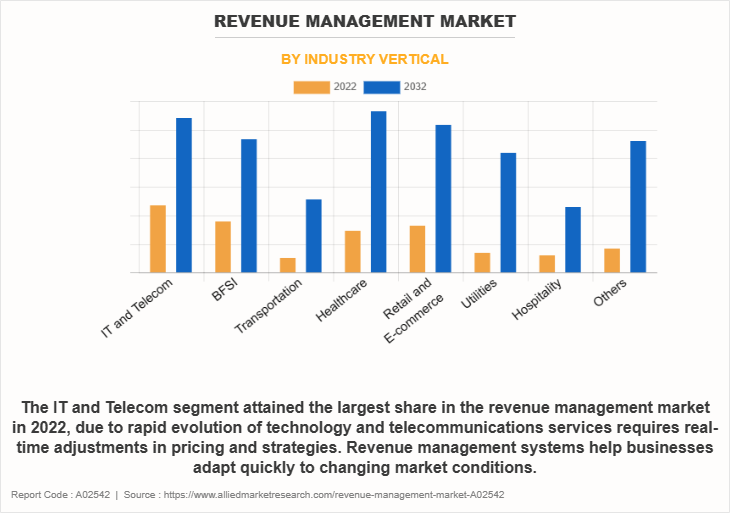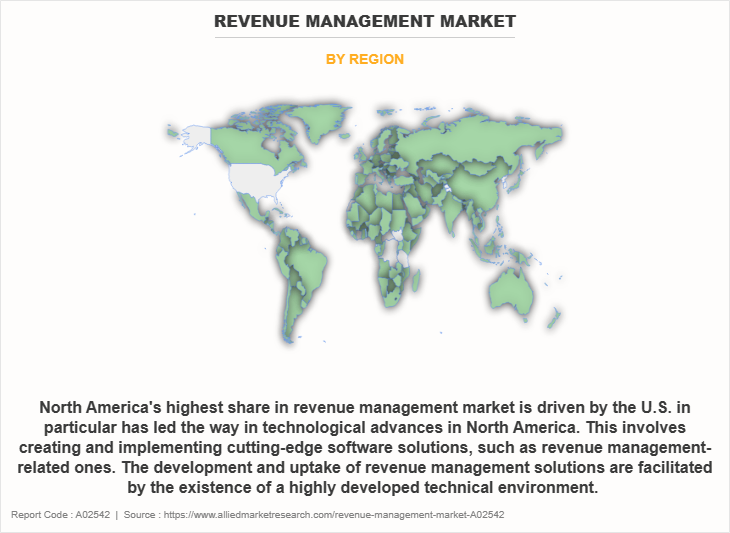Revenue Management Market Insight: 2032
The global revenue management market was valued at $19.9 billion in 2022, and is projected to reach $69.2 billion by 2032, growing at a CAGR of 13.6% from 2023 to 2032.
Rise in need for competitive pricing strategy is a significant driver of the growth of the market. To address this demand, the revenue management industry offers companies the tools and technology necessary to evaluate competition pricing, track market trends, and dynamically modify price plans in real time. By utilizing competitive price strategic technologies, businesses can improve their capacity to determine competitive and strategic prices, optimize income potential, and react quickly to changes in the market. Furthermore, utilize technology and automation has driven the demand for the revenue management market.
However, lack of skilled professional to operate revenue management systems has hampered the growth of the revenue management market as the need for people with the knowledge and skills to efficiently install and oversee such complex systems is growing as companies realize how important it is to maximize revenue and optimize pricing strategies. Companies may find it challenging to fully utilize the potential of revenue management systems due to the scarcity of qualified personnel. Moreover, lack of software affordability in developing countries are major factors that hamper the growth of the market.
On the contrary, implement cross-selling and upselling strategies to maximize revenue from existing customers is an opportunity for revenue management market. upselling is persuading clients to upgrade or acquire a more expensive version of the product or service, whereas cross-selling is advertising comparable products or services to what a customer has previously purchased. Revenue management system are essential for examining consumer information, preferences, and past purchases in order to find tactical chances for upselling and cross-selling.
Revenue management is the application of disciplined analytics to forecast consumer behavior at the micro-market level, improve product availability, and take advantage of pricing elasticity to maximize revenue growth and consequently profit. Furthermore, selling the right product to the right consumer at the right moment at the right price and in the correct pack is the main goal of revenue management industry. Understanding customers' opinions of a product's value and precisely matching product costs, locations, and availability to each client segment constitute the core of this profession.
Moreover, a hotel benefit greatly from revenue management since it allows for the optimization of available rooms and the maximization of income. And all of this is accomplished by using facts to make well-informed decisions rather than relying solely on intuition. Hotels make sure they cover their expenses and set their prices for services so they turn a profit because they have fixed expenditures regardless of whether or not their rooms are sold.
The report focuses on growth prospects, restraints, and trends of the revenue management market analysis. The study provides Porter’s five forces analysis to understand the impact of numerous factors, such as bargaining power of suppliers, competitive intensity of competitors, threat of new entrants, threat of substitutes, and bargaining power of buyers, on the revenue management market.
Top Impacting Factors:
Penetration of Mobile Devices Worldwide and High Growth in Subscriber Base in Various Region
The widespread adoption of mobile devices, including smartphones and tablets, has led to increased connectivity and internet usage. As more people access online services and engage in digital transactions via their mobile devices, businesses need effective revenue management strategies to optimize pricing, offer personalized services, and capture revenue opportunities. Furthermore, with the increasing demand for data services, including mobile internet and streaming, telecom operators and service providers face the challenge of managing network resources efficiently.
Revenue management systems help optimize pricing for data plans, manage network traffic, and ensure a positive customer experience. Moreover, the expansion of telecommunications networks in developing regions has led to a surge in new subscribers. To capitalize on this growth and maximize revenue potential, telecom operators often implement revenue management solutions to handle the increased complexity of pricing structures and subscriber management.
In addition, mobile apps, digital content, and subscription services often employ dynamic pricing models. Revenue management systems enable businesses to adjust prices based on user b behavior demand, and market conditions, ensuring that pricing strategies align with business goals and market dynamics. Therefore, penetration of mobile devices worldwide and high growth in subscriber base in various regions drive the demand for revenue management market size.
Rise in Need for Competitive Pricing Strategy
The pricing strategies of firms are influenced by a variety of factors, including shifting consumer preferences, rivalry, and prevailing economic conditions. Real-time analysis of market dynamics and subsequent pricing strategy adjustments are made possible by revenue management systems for enterprises. Furthermore, setting prices is only one aspect of effective revenue management another is optimizing pricing techniques to maximize profitability. Companies aim to find the right balance between guaranteeing strong profit margins and luring customers with competitive pricing.
Moreover, revenue management systems make use of data analytics to comprehend the unique preferences and behaviors of each consumer. This facilitates the implementation of customized pricing strategies by organizations, customizes offers to target customers, and augments their competitiveness. Furthermore, to maintain their competitiveness, organizations must promptly adjust to new market developments. The flexibility to modify price strategies in response to shifting market conditions, variations in demand, or shifts in industry trends is made possible by revenue management systems. Therefore, rise in need for competitive pricing strategy is driving the demand for revenue management market share.
Lack of Skilled Professional to Operate Revenue Management Systems
Since revenue management systems are frequently complex, a thorough understanding of data analytics, pricing strategies, and business procedures is necessary. To efficiently manage the complexities of these systems, skilled professionals are required. Moreover, making wise choices in revenue management requires evaluating huge datasets. To appropriately analyze the data, extract useful insights, and put strategies into action that support corporate goals, one needs to be a skilled professional. In addition, revenue management is a dynamic sector where technology and approaches are always evolving. In order to guarantee maximum system usage, skilled experts need to stay up to date on the newest trends and advances.
Furthermore, diverse industry has distinct obstacles and demands for revenue management. Professionals with expertise in a certain field customize plans to fit the unique requirements of the company. Moreover, there might not be as many official training courses available that concentrate on revenue management systems. The lack of qualified experts in the sector is partly caused by this lack of educational options. Therefore, lack of skilled professional to operate revenue management systems is hampering the growth of revenue management market growth.
Implement Cross-selling and Upselling Strategies to Maximize Revenue from Existing Customers.
Revenue management systems employ data analytics to gain insight into the behavior, preferences, and past purchases of its customers. Through customer segmentation based on profiles and behaviors, organizations increase the likelihood of success by customizing cross-selling and upselling offers to target certain consumer segments. Furthermore, revenue management systems assist organizations in creating personalized offers by evaluating customer data and understanding individual preferences, allowing for a more targeted and attractive approach. Successful cross-selling and upselling require personalized recommendations.
Moreover, real-time insights into consumer interactions and industry trends are offered by revenue management systems. This makes it possible for companies to decide quickly when and how to make cross-selling and upselling offers in order to get the most impact.
In addition, a common component of upselling and cross-selling strategy is price adjustment based on a variety of variables. With the help of revenue management systems dynamic pricing features, companies instantly adjust prices to be more competitive and appealing to consumers. Therefore, the revenue management market offers the ability to maximize revenue from current customers by implementing cross-selling and upselling methods.
Segment Review
The revenue management market is segmented on the basis of component, deployment mode, industry vertical, and region. On the basis of component, the market is divided into solution (Billing and Payment, Price Management, Revenue Assurance and Fraud Management, and Channel Management), and service. By deployment mode, it is bifurcated into On-premise, and Cloud. On the basis industry vertical, it is classified into IT and Telecom, BFSI, Transportation, Healthcare, Retail and E-commerce, Utilities, Hospitality, and others. On the basis of region, it is analyzed across North America, Europe, Asia-Pacific, and LAMEA.

On the basis of industry vertical, the IT and Telecom segment attained the highest market share in 2022 in the revenue management market. This be attributed to the fact that the rapid evolution of technology and telecommunications services requires real-time adjustments in pricing and strategies. Revenue management systems help businesses adapt quickly to changing market conditions. Meanwhile, the utilities segment is projected to be the fastest-growing segment during the forecast period. This is attributed to the fact that complex pricing structures are frequently used by utilities to determine charges for various consumer demographics, consumption patterns, and time of use. Utilities can manage and optimize such complex pricing structures with the help of revenue management tools, which guarantees precise billing and revenue collection.

On the basis of region, North America attained the highest market share in 2022 and emerged as the leading region in the revenue management market. This is attributed to the fact that the U.S. in particular has led the way in technological advances in North America. This involves creating and implementing cutting-edge software solutions, such as revenue management-related ones. The development and uptake of revenue management solutions are facilitated by the existence of a highly developed technical environment.
On the other hand, the Asia-Pacific region is projected to be the fastest-growing region for the market during the forecast period. This growth is attributed to the fact that a rapid economic growth has been observed in many countries in Asia-Pacific region, such as China and India. This expansion frequently causes business activity to rise, which in turn raises the need for effective revenue management strategies to maximize cash flow.
Competitive Analysis
Cerillion Technologies, RealPage Inc., Oracle Corporation, Huawei Technologies Co., Ltd., Calix, Inc., Fiserv, Inc., Workday, Inc., SAP, Accenture, ATOMIZED
Recent product launch in the revenue management market
In October 2023, SevenRooms, a guest experience and retention platform for the hospitality industry, launched a revenue management solution for restaurants. The product serves as an engine for operators to generate more sales and profitability from the same seats, using data science to recommend how to optimize availability and increase table utilization. This approach is expanded to the restaurant sector via revenue management market forecast. Because the solution automates these processes, managing changes doesn't require analysts, more employees, or costly consultants.
Recent product launch in the revenue management market
In March 2022, nThrive, Inc., a healthcare revenue management platform provider, launched the End-to-End Revenue Management Platform. The platform is underpinned by an intelligent foundation of pre-trained automations, predictive models, and contextually aware billing and coding reference materials, which, together, help provider teams accelerate accurate financial recovery for their health systems. The aim of Thrive's Revenue Management Platform is to enable every revenue professional to have the greatest possible influence on the bottom line of their company. Health systems may achieve flywheel effect value, simplify vendor management, and make sure that all relevant revenue is charged and collected from the point of service to the final payment by utilizing nThrive's Revenue Management Platform.
Key Benefits for Stakeholders
- This report provides a quantitative analysis of the market segments, current trends, estimations, and dynamics of the revenue management market.
- from 2022 to 2032 to identify the prevailing revenue management market opportunities.
- Market research is offered along with information related to key drivers, restraints, and opportunities.
- Porter's five forces analysis highlights the potency of buyers and suppliers to enable stakeholders to make profit-oriented business decisions and strengthen their supplier-buyer network.
- In-depth analysis of the revenue management market segmentation assists to determine the prevailing market opportunities.
- Major countries in each region are mapped according to their revenue contribution to the global market.
- Market player positioning facilitates benchmarking and provides a clear understanding of the present position of the market players.
Revenue Management Market Report Highlights
| Aspects | Details |
| Market Size By 2032 | USD 69.2 billion |
| Growth Rate | CAGR of 13.6% |
| Forecast period | 2022 - 2032 |
| Report Pages | 485 |
| By Component |
|
| By Deployment Mode |
|
| By Industry Vertical |
|
| By Region |
|
| Key Market Players | Calix, Inc., ATOMIZED, Fiserv, Inc., Workday, Inc., Huawei Technologies Co., Ltd., SAP, Accenture, RealPage Inc., Oracle Corporation, Cerillion Technologies |
Analyst Review
The demand for advanced revenue management systems is driven by the continuing digital revolution occurring across industries. Income management systems are essential for optimizing pricing and generating income in the digital environment, as businesses increasingly use digital media. Furthermore, artificial intelligence (AI) and data analytics applications are key growth drivers. Businesses make more intelligent and strategic revenue management decisions by utilizing advanced analytics to obtain insights into consumer behavior, market trends, and competition intelligence. Moreover, the use of dynamic pricing schemes is becoming more widespread. Companies understand that in order to stay competitive and optimize revenue, they must constantly modify prices in response to variables including demand, competition pricing, and market conditions. In addition, the challenge of handling revenue across several locations rises when firms go global. Revenue management solutions support firms' growth objectives by assisting them in navigating a variety of markets, currencies, and regulatory environments. Furthermore, revenue management opportunities are created by the growth of subscription-based services in a number of industries, such as software, streaming, and e-commerce. Key factors driving demand for revenue management solutions include subscription pricing optimization and recurring income stream management. Moreover, the demand for flexible and aggressive pricing tactics is brought about by the expansion of e-commerce and online retail. Revenue management systems enable companies to modify prices in response to many factors, such as customer behavior and the dynamics of the online market. In addition, customer experience is becoming more and more important to businesses. Revenue management systems assist in customizing promotions and prices to improve consumer loyalty, contentment, and overall experience.
Furthermore, market players have adopted various strategies for enhancing their services in the market and improving customer satisfaction. For instance, in February 2020, RealPage launched AI revenue management, a multifaceted strategy to revenue optimization that boosts income by using personnel, credit, price, and demand. In o Early users in the beta program are generating incremental yields of 100–200 bps. Additionally, with its precision pricing capabilities, AI Revenue Management keeps the company in the most revenue-optimal position. Building on extensive experience with millions of units and decades of successful results, AI Revenue Management delivers data-driven AI machine learning insights for balancing supply and demand at your property and provides recommendations that optimize performance. Moreover, In October 2023, SevenRooms, a guest experience and retention platform for the hospitality industry, launched a revenue management solution for restaurants. The product serves as an engine for operators to generate more sales and profitability from the same seats, using data science to recommend how to optimize availability and increase table utilization. This approach is expanded to the restaurant sector via revenue management. Because the solution automates these processes, managing changes does not require analysts, more employees, or costly consultants. These strategies by the market players operating at a global and regional level are expected to help the market to grow significantly during the forecast period.
Some of the key players profiled in the report include Huawei Technologies Co., Ltd., Oracle, Fiserv, Inc., Accenture, SAP, Workday, Inc., Cerillion, RealPage Inc., Calix, and Atomize. These players have adopted various strategies to increase their market penetration and strengthen their position in banking-as-a-service.
The upcoming trends in the revenue management market is the adoption of AI and ML in revenue management systems. These technologies were being used to analyze vast amounts of data, predict customer behavior, and optimize pricing strategies dynamically. Many businesses are transitioning to cloud-based revenue management solutions. Cloud platforms offer scalability, flexibility, and improved accessibility, allowing companies to efficiently manage their revenue processes.
Solution is the leading application of revenue management market.
North America is the largest regional market for revenue management.
$69,162.66 million is the estimated industry size of revenue management.
Huawei Technologies Co., Ltd., Oracle, Fiserv, Inc., Accenture, SAP, Workday, Inc., Cerillion, RealPage Inc., Calix, and Atomize are the top companies to hold the market share in revenue management
Loading Table Of Content...
Loading Research Methodology...



